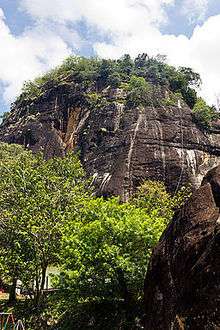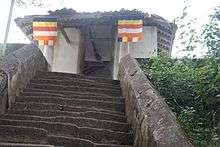Mulkirigala Raja Maha Vihara
| Mulkirigala Raja Maha Vihara මුල්කිරිගල රජ මහා විහාරය | |
|---|---|
 | |
| Basic information | |
| Location | Mulkirigala , Sri Lanka |
| Geographic coordinates | 06°07′22.97″N 80°44′10.95″E / 6.1230472°N 80.7363750°ECoordinates: 06°07′22.97″N 80°44′10.95″E / 6.1230472°N 80.7363750°E |
| Affiliation | Buddhism |
| District | Hambantota |
| Province | Southern Province |
| Heritage designation | Archaeological protected monument[1] (8 April 1988) |
| Architectural description | |
| Architectural type | Buddhist Temple |
| Architectural style | Cave temple |
| Founder | King Saddhatissa |
Mulkirigala Raja Maha Vihara (Sinhalese: මුල්කිරිගල රජමහා විහාරය, also known as Mulkirigala Rajamaha Viharaya) is an ancient and an archaeological Buddhist temple in Mulkirigala Sri Lanka. The temple site is situated 2 km (1.2 mi) from the Mulkirigala Junction and can be reached from either Dikwella or Tangalle. It is also known as the Little Sigiriya[2]
History
According to the ancient chronicle Mahavamsa, the Mulkirigala temple was constructed by King Saddhatissa in the third century.[3] After this period the temple received royal patronage by numerous successive kings. In 461-479 AD period a stupa was constructed at Mulgirigala was by King Datusena and the temple was further developed by King Kirti Sri Rajasinghe (1747-1782).[4]

Name
The common name of temple is Mulkirigala, but it is also referred to as Mulgirigala, Muvathitigala, Muhudungiri and Dakkhina Vihara.[5]
As mentioned in the Bodhi Vamsa chronicle, one of the temples known as Giriba Viharaya where one of a Bo sapling out of 32 saplings germinated from Jaya Sri Maha Bodhi is planted, which was currently identified as Mulkirigala temple.
During the Polonnaruwa period this temple was known as Samuddagiri Viharaya, according to the Rev. Kamburupitiya Wanaratna Thero who had read the stone inscription of the pond.
Also with the arrival of the Europeans, Mulkirigala was named as Adam’s Berg. It is believed that Europeans confused Mulkirigala with the Sri Pada (Adam’s Peak) and have believed tombs of Adam and Eve were located here.[3][5]
Location
The temple is built on a rock 205 m (673 ft) above sea level and there are 533 steps to the summit.[4] The rock is surrounded by Benagala, Kondagala, Bisogala and Seelawathiegala, these rocks all have Buddhist shrines.
Temple Plan

The temple comprises seven Viharas and seven Buddha statues, with the viharas constructed in five compounds. These are: Siyambalamaluwa, Lower Vihara Compound, Bomaluwa, Rajamaha Vihara Compound, and Upper Vihara Compound.[6]
Siyambalamaluwa
Siyambalamaluwa consist with Mulkirigala Museum, Temple and Rest House. It is at the surrounding ground level.
Lower Vihara Compound
This consists of a rock inscription, Raja Maha Viharaya, tombs, Seemamalakaya, Monastery and Paduma Rahath Viharaya, which has a large reclining Buddha image. There is also a small painted pagoda found inside the cave. Additionally an information centre has been established in this terrace.
Bomaluwa
Bomaluwa mainly consist with Vesak Hall Compound, Majjhima Nikaya Rock Cave (Bhanaka cave), Viharagal Rock Inscription (6-7 Century), and Bomaluwa (Bo tree terrace).
Raja Maha Vihara Compound
The Raja Maha Vihara terrace includes Piriniwan Manchakaya, Raja Maha Viharaya, Aluth Viharaya (New Vihara), Naga Viharaya, Pond, Rock Inscription (12 Century), Lamp Post and Diyagoda Etha Viharaya. The new vihara had been renovated around 1918.[6] The rock inscription giving the ancient name of Mulkirigala as Muhundgiri.[4]
Upper Vihara Compound

Dethispala Bodhiya, Attendant Boddhiya, Garandi Kapolla, Chaitya, Bell, Pond and Horizon Valley can be seen in upper vihara compound. Dethispala Bodhiya is believed to be one of 32 sapling, brought from Anuradhapura where the original at Jaya Sri Maha Bodhi.[7]
Paintings
Mulkirigala Viharaya contains many Kandy era wall paintings based on Jataka stories, such as Wessanthara, Telapatta and Shivi.
See also
References
- ↑ "Protercted Monument List 2012-12-12" (PDF). Department of Archaeology. 12 December 2012. Retrieved 27 March 2016.
- ↑ "Mulkirigala Rock Temple : Devotion carved in rock by Srimal FERNANDO". African Asian News (AAN). 20 December 2009. Retrieved 24 June 2015.
- 1 2 "Mulkirigala Raja Maha Viharaya – මුල්කිරිගල රජමහා විහාරය". amazinglanka. 3 February 2007. Retrieved 24 June 2015.
- 1 2 3 "Mulgirigala (Mulkirigala) rock monastery, Sri Lanka". mysrilankaholidays. Retrieved 24 June 2015.
- 1 2 "The rock temple down south". sundaytimes. Retrieved 24 June 2015.
- 1 2 "Mulkirigala Temple-Southern Sri Lanka's magnificent Rock Temple Complex". srilankaview. Retrieved 24 June 2015.
- ↑ "Mulkirigala Rock Temple". elephanttravels. 13 September 2013. Retrieved 24 June 2015.
External links
- J.B.Disanayaka " Mulgirigala"- Sinhala Edition